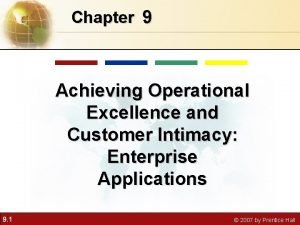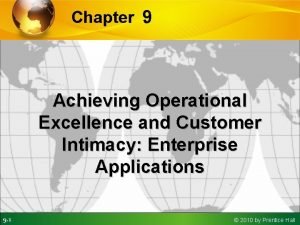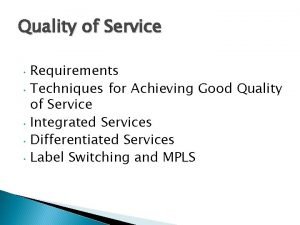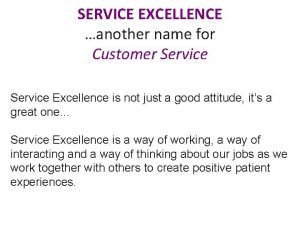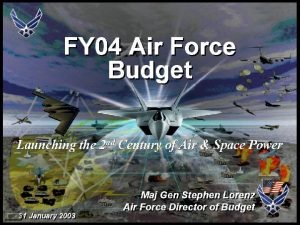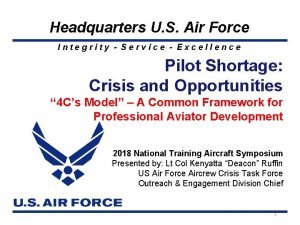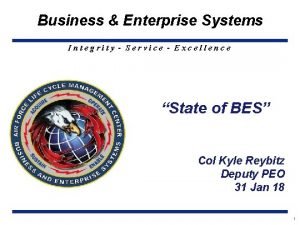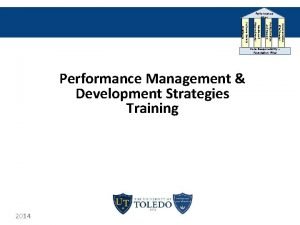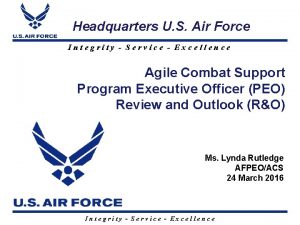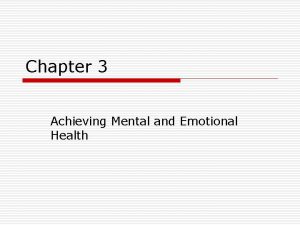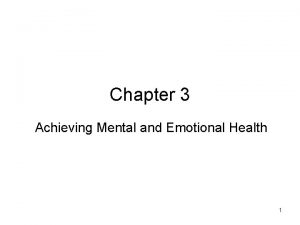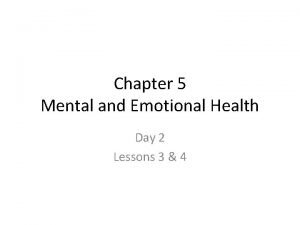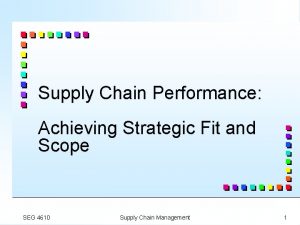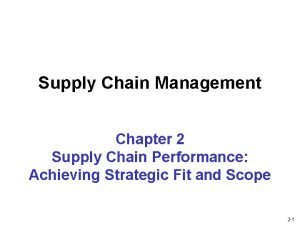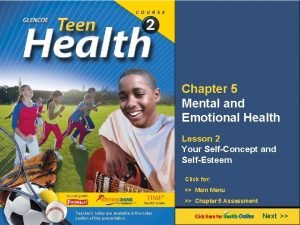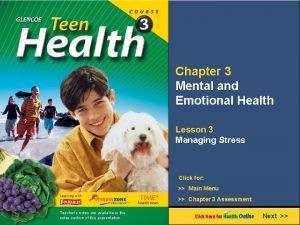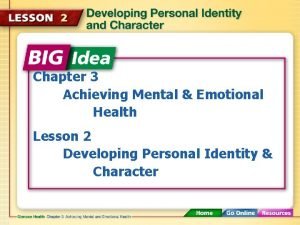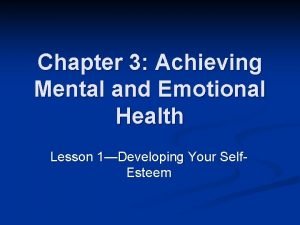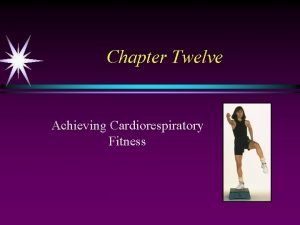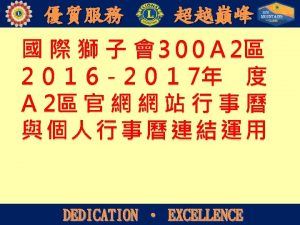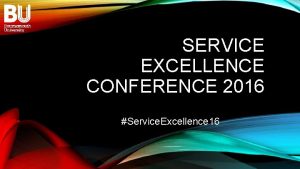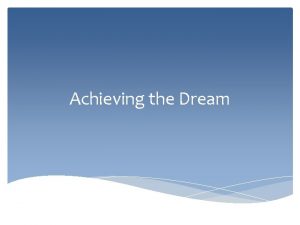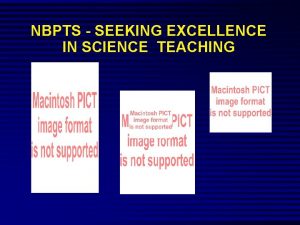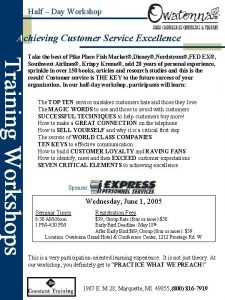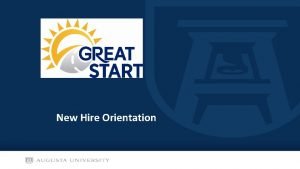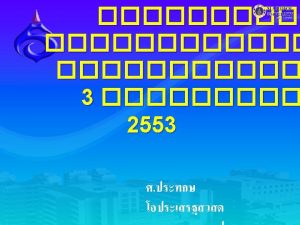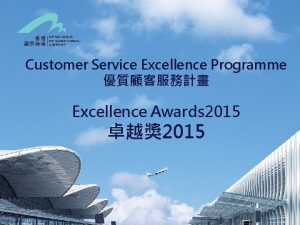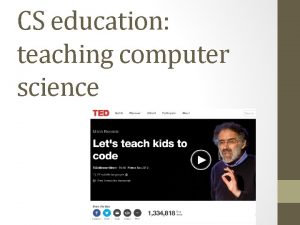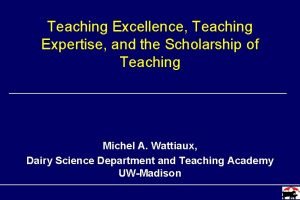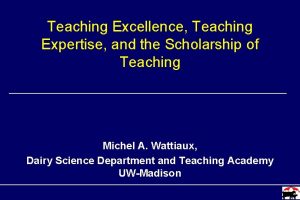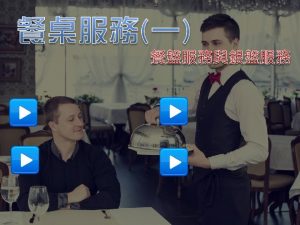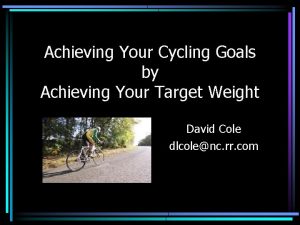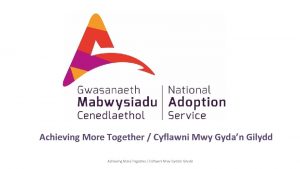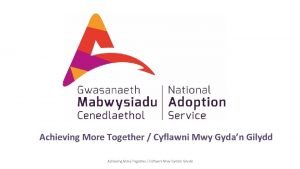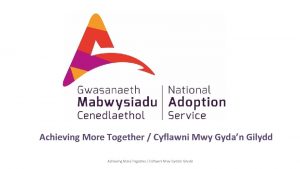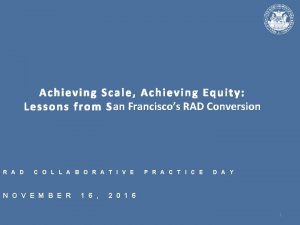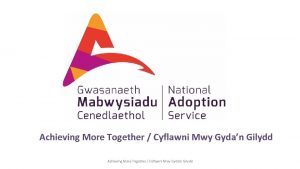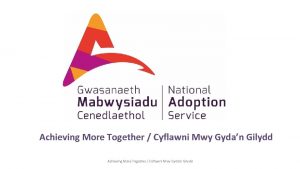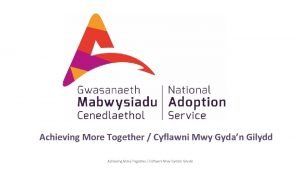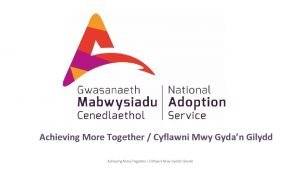Achieving EXCELLENCE in Science Teaching and Service Dr




























- Slides: 28

Achieving EXCELLENCE in Science, Teaching, and Service Dr. Michael Nosonovsky University of Wisconsin-Milwaukee Prepared for the tenure review process Department of Mechanical Engineering College of Engineering and Applied Science 2014

Content • Excellence in research – Scientific discoveries and results – Excellence in publication – Funding • Teaching and mentoring • Service

Excellence in Research • "Dr Nosonovsky is a highly successful, productive and original scholar with an impressive publication record. He performs outstanding cutting-edge research in various areas of mechanics of materials related to surface science and tribology" (CEAS Excellence in Research Award, 2013).

Ph. D lineage (from the Math Genealogy Project) “Standing on the shoulders of Giants!” Michael Nosonovsky (2001) ← George G. Adams (1975) ← David B. Bogy (1966) ← Eli Sternberg (1945) ← Michael A. Sadowsky (1927) ← Georg Karl Wilhelm Hamel (1901) ← David Hilbert (1885) ← Carl Louis Ferdinand Lindemann (1873) ← Felix Christian Klein (1868) ← Rudolf Otto Sigismund Lipschitz (1853) ← Martin Ohm (1811) ← Karl Christian von Langsdorf (1781) ← Abraham Gotthelf Kästner (1739) ← Christian August Hausen (1713) ← Johann Andreas Planer (1709) ← Johann Pasch (1683) ← Michael Walther, Jr. (1661) ← Johann Andreas Quenstedt (1644) ← Christoph Notnagel (1630) ← Ambrosius Rhodius (1610) ← Melchior Jöstel (1600) ← Valentinus Otho (1570) ← Georg Joachim von Rheticus (1535) ← Nicolaus Copernicus (1499) ← Leonhard von Dobschütz

Scientific discoveries / results by Michael Nosonovsky and his colleagues • Lowest negative pressure in water ever measured / observed • Explanation of the role of hierarchical roughness on superhydrophobicity • Explanation of multiscale mechanisms of friction and their relation to the Second Law of Thermodynamics • General thermodynamic framework for self-lubrication, self-healing, and selfhealing materials • First observation of Cassie-Wenzel wetting transitions in underwater oleophobicity • Pioneering studies of icephobicity and its relation to superhydrophobicity • Participation in the synthesis of first ever superhydrophobic concrete • Green tribology studies

Lowest negative pressure in water ever measured • Water can sustain negative pressure (tensile stress) if measures are taken to prevent cavitation (bubbling), e. g. , at the nanoscale. The tensile strength limit of water (“spinodal limit”) is somewhere in between -150 MPa and -400 MPa at 300 K • It is difficult to measure it at the macroscale • We used AFM in a creative way to measure negative pressure in water nano-menisci (capillary bridges) at different relative humidity R t Tip R 21 R 2 Sample a 1

Lowest negative pressure in water ever measured • The value found was about -80 MPa (world record), Yang, Nosonovsky*, Zhang and Chung, Chem Phys Lett 451: 88, 2008 • *Corresponding author; the work was performed by four postdocs at NIST; Yang and Nosonovsky were the leaders • The paper has been cited by 34, caused some discussion in the literature • Additional publications: – M Nosonovsky, B Bhushan. “Phase behavior of capillary bridges: towards nanoscale water phase diagram” Physical Chemistry Chemical Physics 10 (2008), 2137 -2144 – Yang, Nosonovsky*, Zhang & Chung, Chem. Phys. Lett. 463 (2008), 286287

Explanation of the role of the hierarchical roughness in superhydrophobicity • M Nosonovsky Multiscale roughness and stability of superhydrophobic biomimetic interfaces Langmuir 23 (2007), 3157 -3161 Cited by 232 • Why superhydrophobic surfaces have hierarchical structure with smaller (nanoscale) details imposed on larger (macroscale) details? • The paper provides a mathematical explanation of the stabilizing effect of the multiscale roughness

Multiscale mechanisms of friction • Dr. Nosonovsky has developed an original theory of friction, which is described in his book • Friction is a universal phenomenon: from nano. Newtons to billons of tons, all materials, all friction mechanisms same simple Coulomb law works • The law of friction should be derived from the 2 nd law of thermodynamics • We proposed a procedure, how to do this (using Onsagers approach in non-equilibrium thermodynamics and asymptotic transition from the bulk to the interface) • The theory is also related to friction-induced selforganization

Materials with the capacity for selforganization • Dr. Nosonovsky and V. Mortazavi extended the field of friction-induced vibrations to nonmechanical effects coupled with friction (e. g. , formation of tribofilms) and showed that these are governed by similar equations • The approach is applied to self-lubricating, selfhealing, and self-cleaning biomimetic materials by Nosonovsky & Rohatgi

First observation of the Cassie-Wenzel transitions in underwater oleophobicity • The C-W wetting transition is well known for solid-air-water systems • We found an evidence (an abrupt change of the contact angle) for such a transition in solid-water -oil systems with brass • Reported in Hejazi, V. ; Nyong, A. E. ; Rohatgi, P. K. Nosonovsky*, M. ; Adv. Mater. 2012, 24: 5963 (high impact) (*corresponding author)

Icephobicity • Surface roughness-induced Icephobicity is a novel area related to the superhydrophobicity • Dr. Nosonovsky proposed a thermodynamic definition of the icephobicity using the entropic and enthalpic criteria, which is parallel to the definition of the hydrophobicity • Was reported in high-impact journals V. Hejazi, K. Sobolev, M. Nosonovsky*, Scientific reports, 2013, 3, 2194 Nosonovsky*, M. , and Hejazi, V. , ACSNano, 2012, 6 (10), 8488 -8491

Superhydrophobic and Icephobic Concrete • Concrete is typically a hydrophilic material, which is a problem (water and ice cause cracks) • We participated in the team work (led by Prof. K. Sobolev) in the breakthrough discovery of superhydrophobic concrete • Reported in I. V. Flores, V. Hejazi, K. Sobolev, M. Nosonovsky*, Applied Materials and Interfaces, 2013, 5: 13284– 13294 (impact factor=5. 0) (*corresponding author)

Green Tribology • Green Tribology (ecotribology) was suggested by Peter Jost (the founder of tribology) at WTC 2009 in Kioto as a way to attract politicians and broad public to tribology • We published first scientific book and first special issue volume on Green Tribology (before, economists, not scientists wrote about the Green Tribology) • Dr. Nosonovsky suggested to view the Green Tribology as synthesis of three areas: green lubrication, biomimetic tribology, and tribology renewable energy • Dr. Nosonovsky formulated “ 12 principles of GT” (similar to “ 12 principles of Green Chemistry”); these principles were used, for example, by the ASIATRIB 2014 conference organizers as official ones.

What press says • "In 2007, Nosonovsky showed that if you got the architecture of a surface’s roughness just right, creating caves, nooks and crannies that bend back in on themselves, you could create repulsive surface forces equating to huge contact angles for all sorts of liquids. It was a simple but game-changing insight. " (Jessica Griggs, "Omniphobia: the stuffs that stick at nothing" New Scientist on 24 November 2012, p 46 -49) • "Although superhydrophobic surfaces repel water, do they keep off ice as well? Not always. As Michael Nosonovsky and Vahid Hejazi at the University of Wisconsin. Milwaukee explain, the often-bumpy of superhydrophobic surfaces traps air pockets between the solid and the liquid. When water freezes, these air pockets become the basis of cracks in the ice, and the larger cracks are, the easier it is to dislodge ice off a surface. " (Charles Q. Choi "Worth Pitching? : Mysteries of Rain and Ice" Scientific American, October 5, 2012) • "In 2007, Nosonovsky created a theoretical surface architecture that addressed superhydrophobicity at both nano- and microscales, with crannies that bent back in on themselves. It was used by scientists at the Massachusetts Institute of Technology to make ketchup bottles that allowed the product to slide out without sticking to the sides" ("Super-surfaces suggested by nature" By Laura L. Hunt, UWM News, August 23, 2013)

What colleagues say • "This is very impressive! Keep up your quality of work. We need such quality at UWM!" (Prof. Ryoichi S. Amano, UWM) • "You are extremely productive as always hitting top journals. I take pride as you started with me when you were a young scientist and I have seen you grow. " (Prof. Bharat Bhushan, Ohio State University) • "Michael, This is great that you have been able to publish about self-healing, self-lubricating and self-cleaning materials in Nature. This will certainly advance our efforts in this area… Dr. Nosonovsky is the best theoretician with whom I ever worked… I will not be surprised if Dr. Nosonovsky will receive a Nobel Prize one day!" (Prof. Pradeep K. Rohatgi, UWM) • “The ME department [should appreciate] excellent scholarly contributions such as by Michael Nosonovsky in promotion considerations. ” (Prof. Krishna Pillai, UWM)

Funding record • "An attempt will be made to consider past accomplishments and probable future contributions in these areas. No candidate will be considered for promotion to associate professor with tenure without evidence of continuous research scholarship and accomplishments, including refereed publications and efforts to raise funds. ” (Natural Science Division tenure promotion criteria) • Proposals submitted as PI 2009 -2014: – – – NSF 12 proposals DOE 2 proposals Army 6 proposals Other external about 10 proposals Internal about 10 proposals Many dozens of short white papers and pre-proposals to various sources

Funding record External proposals funded (Total proportion to the applicant about $216. 5 k) • • • M. Nosonovsky (sole PI) INSIC unrestricted research grant “BIOMIMETIC COATINGS TO PROTECT THE HEAD-TAPE INTERFACE” $36. 5 k, March 2010 -Dec 2011 P. Rohatgi (PI) & M. Nosonovsky (co. PI) “Advanced design and novel in-situ synthesis of selfcleaning and wear-resistant metallic surfaces for water industry components” NSF IUCRC FR, $199, 99 k, August 2013 -August 2015 (proportion to the applicant ~$50 k) P. Rohatgi (PI) and M. Nosonovsky (co-PI) NSF I/UCRC “SELF-CLEANING MATERIALS FOR WATER INDUSTRY”, $176 k, July 2010 -July 2015 (proportion to the applicant ~$65 k) K. Sobolev (PI), M. Nosonovsky (co-PI) and others "Anti-Icing and De-Icing Superhydrophobic Concrete to Improve the Safety on Critical Elements of Roadway Pavements and Bridges, " CFIRE, $146. 5 k, October 2012 -October 2013 (proportion to the applicant ~$35 k). M. Nosonovsky (sole PI) “Environmentally benign biomimetic antifouling coatings” Bradley Catalyst, $30 k Internal proposals funded (Total proportion to the applicant about $281 k) • • • M. Nosonovsky (PI), P. Rohatgi (co-PI) and E. Wornyoh (co-PI) “Self-organization at the sliding interface: towards biomimetic self-lubrication and self-replenishing” $399 k, UWM Research Growth Initiative, July 2010 -December 2012 (proportion to the applicant – ~$133 k) M. Nosonovsky (PI), K Sobolev (co-PI) “Superhydrophobic 3 D concretes and surfaces” $267 k, UWM Research Growth Initiative, July 2012 -June 2014 (proportion to the applicant $133 k) M. Nosonovsky Graduate School Research Committee Award (GSRCA), 2011, $14. 9 k (not used)

Excellent publication record (citations) Hirsch = 28, Total citations = 3369

Excellent publication record (books) Special Issue "Entropy and Friction

Excellent publication record (interesting facts) • Dr. Nosonovsky is currently among top 5 most cited scientists in the rank of Assistant Professor of Mechanical Engineering in the US and in the World • Dr. Nosonovsky is the most cited junior faculty in the UWM and in Milwaukee county; he is also among 5 top most cited local scientists if citation for the past 5 years is considered • The review paper M. Nosonovsky and B. Bhushan, “Superhydrophobic Surfaces and Emerging Applications: Non-adhesion, Energy, Green Engineering, ” Current Opinions Coll. Interface Sci. 14 (2009) 270280 is among three most cited UWM papers published since 2005 (193 citations) • Dr. Nosonovsky is the only UWM scientists who published in Nature in the past 5 years (and maybe more) • Dr. Nosonovsky published in high-profile journals: nature (IF=36. 28); Advanced Materials (IF=13. 88), ACS Nano (IF=10. 77), Adv. Functional Materials (IF=10. 18), Mater Sci. & Engineering-Reports (IF=17. 7), Nano Letters (IF=13. 2) • Dr. Nosonovsky published several papers in Phil Trans Royal Soc and served as an invited co-editor of the special issue of that journal. This is the oldest journal in the world where Isaac Newton published his work.

EXCELLENCE in Teaching and Mentoring • Growing student evaluations (shown until Fall ‘ 13) • New course ME 490 “Special Topics in ME – Functional and Biomimetic Surfaces” (Spring 2011, Spring 2015) • Participated in NSF Research Experience for Teachers with teacher Mr. Bounket, published a paper • M. Nosonovsky and S. Bounket “From university lab to urban school: teaching cutting edge biomimetic technology” World Transactions on Engineering and Technology Education, Vol 10 (2012) 204 -208 Mr. Sombath Bounket, one of the best MPS teachers, measures CA hysteresis in the PI’s lab during his training under the RET project in July 2012. In Fall 2012 he will use his knowledge to teach high-school students about the biomimetic surfaces [166].

Graduate students mentored (Ph. D) • Vahid Hejazi (Ph. D, May 2014) – Thesis “Wetting, Superhydrophobicity, and Icephobicity in Biomimetic Composite Materials” – Graduate Fellowship (2012/13), – Dissertator Fellowship (2013/14) – CEAS Student Academic Excellence Award (2013) – Ph. D resulted in 8 papers in high-profile journals, more than 100 citations since 2011; 3 book chapters – Now at Rice University • Vahid Mortazavi (Ph. D, May 2014) – Thesis “Modeling instabilities and self-organization at the frictional interface” (co-advisor Dr. Roshan D’Souza) – Dissertator Fellowship (2013/14) – Ph. D resulted in a monograph, 5 papers and 3 book chapters • Rahul Ramuchandran (Doctoral candidate since April 2014) – Thesis “Non-adhesive Surfaces: Superhydrophobicity, Icephobicity, Corrosion Inhibition, and Water-oil Separation”

Graduate students mentored (M. Sc. ) • Chuanfeng Wang (MSc, May 2010) – Thesis “Transient Processes in Friction: Running-in, Selforganization, and Thermo-elastic Instabilities” – One journal paper – Currently a doctoral student at Georgia Tech • Mehdi Mortazavi (MSc, December 2011) – Thesis “Wetting and superhydrophobicity in polymeric materials” – One journal paper, two book review chapters – Currently a doctoral student at Florida University • Md Haider Ali (MSc, December 2013) – Thesis “Gait and Locomotion Analysis for Tribological Applications” • Served on theses committees of 14 graduate students

What students / alumni say • "I was doing well in my classes, but nothing really caught my attention until I took Professor Nosonovsky's class on biomimetic and functional surfaces, I just immediately loved it. . When I compared what I was doing in Professor Nosonovsky's lab with my options in traditional engineering, I decided my money was on the freshwater applications. Especially after my research paper was published, I knew this was the field I wanted to continue in. " (Tyler Hurd, engineer at Pentair, Glendale, WI) • "Dr. Nosonovsky is a great and very patient and one of the best instructors I have had at UWM. . . I especially liked taking Mechanical Vibrations with him as he taught the a completely different approach to solving vibration problems that we were not familiar with from our undergraduate engineering classes" (Ohganetega Anene-Maidoh, graduate student at Georgia Tech)

EXCELLENCE in Service • • • University Service ME Graduate Program Committee (since 2009) CEAS Scholastic appeals committee (2012 -2014) Outreach for WUWM “UWM Today” (program on Oct 24, 2013) Faculty advisor for the “Chabad at UWM” Jewish religious student group (since 2011) Service for Profession Reviewed many dozens of articles for dozens of journals including very prestigious ones (Nature, Nature Sci Rep, Nature Comm, JACS, ACS Nano, Nano Letters and PTRS) and regular journals of ASME, ACS, APS, AIP and others Reviewed proposals for the NSF, Israel Science Foundation, ACS Petroleum foundation, Canadian Discovery foundation, Swiss Science Foundation, Netherlands’ Technology Foundation STW, etc.

EXCELLENCE in Service • • Service for Profession Education Committee of ASME Tribology Division (2009 -2010) Contact Mechanics Committee of ASME Tribology Division (20032006) Executive Committee of ASME Tribology Division (2014 -2019) Editorial board member: Entropy Journal, MDPS, Bazel, Switzerland (Impact factor=1. 3), since 2007 Section Editor, Springer Encyclopedia of Nanotechnology (1 st edition 2012, 2 nd edition 2015) Planning committee for the Graduate workshop “Bio- and Green Tribology” at IJTC 2010 conference in San Francisco (October, 2010) Planning committee for Gear Summit at UWM (May, 2010)

EXCELLENCE in Service for Profession • International Advisory Board member, The Eighth International Conference on Materials Technologies and Modeling (MMT-2014), Israel • Local Planning committee member, 5 th International Symposium on Nanotechnlogy in Construction NICOM-5 (Milwaukee, 2015) • Symposia, section, and session chair: • • • “Nanotribology” session, World Tribology Congress, Kyoto, September 2009 “Nonmetallic materials” session MMT 2010, Ariel, Israel “Surface Engineering” session ESDA 2010, Istanbul, Turkey “Ecotribology” session ASME/STLE International Joint Tribology Conference, San Francisco, CA, October 20, 2010 “Green and Biomimetic tribology” session and symposium) ASME/STLE International Joint Tribology Conference, Los Angeles, CA, October 24 -25, 2011 “Wetting phenomena” session MMT 2012, Ariel, Israel, August 21 -22, 2012
 Achieving operational excellence and customer intimacy
Achieving operational excellence and customer intimacy Customer intimacy operational excellence
Customer intimacy operational excellence Teaching excellence and achievement
Teaching excellence and achievement Tamu english language proficiency
Tamu english language proficiency Techniques for achieving good quality of service
Techniques for achieving good quality of service Another name for customer service
Another name for customer service Integrity service excellence
Integrity service excellence Integrity service excellence
Integrity service excellence Integrity excellence service
Integrity excellence service Four pillars of service excellence
Four pillars of service excellence Alr-69a block diagram
Alr-69a block diagram Eric’s favourite .......... is science.
Eric’s favourite .......... is science. Difference between traditional teaching and micro teaching
Difference between traditional teaching and micro teaching Intentional use of unfriendly or offensive behavior
Intentional use of unfriendly or offensive behavior Chapter 3 achieving mental and emotional health
Chapter 3 achieving mental and emotional health Chapter 3 mental and emotional health answer key
Chapter 3 mental and emotional health answer key Chapter 3 achieving mental and emotional health answer key
Chapter 3 achieving mental and emotional health answer key Chapter 3 achieving mental and emotional health
Chapter 3 achieving mental and emotional health Chapter 15 achieving mental and emotional health answer key
Chapter 15 achieving mental and emotional health answer key Achieving mental and emotional health
Achieving mental and emotional health Strategic fit means
Strategic fit means Implied uncertainty spectrum
Implied uncertainty spectrum Chapter 3 achieving mental and emotional health
Chapter 3 achieving mental and emotional health Chapter 3 achieving mental and emotional health
Chapter 3 achieving mental and emotional health Chapter 3 achieving mental and emotional health
Chapter 3 achieving mental and emotional health Chapter 3 achieving mental and emotional health
Chapter 3 achieving mental and emotional health Chapter 15 achieving mental and emotional health
Chapter 15 achieving mental and emotional health The role of project management in achieving project success
The role of project management in achieving project success Achieving cardiorespiratory fitness can
Achieving cardiorespiratory fitness can
